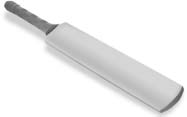
Accusations of ball-tampering were never far from the surface
Cricket can be a dirty business at times, as Michael Atherton showed in 1994 when television cameras caught him applying a little dirt to the ball during a Test between England and South Africa. But, though we’ve chosen dirt to illustrate our object, we could just as well have gone for resin, another substance that has been used in one of cricket’s dark arts – ball-tampering.
It was way back in 1926 that Arthur Mailey, the Australian googly bowler, declared that it was ‘quite in order for a bowler to use resin on his fingers as a means of imparting additional spin to the ball’. The then editor of Wisden, Charles Stewart Caine, asked around the English county circuit and discovered that others too used resin to produce a better rip from the fingers. Pressed on whether they thought this practice within the spirit of the game, the players told Caine that if sawdust was permissible to get a better grip on the ball, why not resin? Caine didn’t buy that, writing in Wisden that ‘sawdust is allowed after rain to restore the condition of the ball to normal; resin clearly brings about a condition that is abnormal’.
Mind you, that wasn’t the only sharp practice exercising the mind of Caine in that year’s issue of Wisden. During the 1925 season a bowler was reported to the MCC after he was seen lifting the seam of the ball. This prompted the MCC to issue a circular to all first-class umpires which reminded them that ‘the practice of lifting the seam by a bowler is illegal and comes within Law 43’. If Caine was ambivalent about using resin to produce greater spin on the ball he was strident in his condemnation of lifting the seam. It was, he wrote, ‘indefensible’ and a scourge that must be stamped out.
It never was, murmurings and accusations never far from the surface during the next seventy years. Then in 1993 former Pakistan captain Imran Khan, one of the most widely respected figures in the game, revealed in his biography that once during a county match for Sussex he had ‘used a bottle-top to roughen the surface of the ball’, for which he was truly sorry. The furore that followed the ‘bemused’ Khan, who was trying to spark an intelligent debate on what constituted ball-tampering, forced him to resign from the ICC cricket committee. His parting shot was to write them a letter in May 1993 recommending that they rewrite the book on ball-tampering. ‘Unfortunately,’ says Khan, ‘the ICC brushed the entire issue under the carpet.’

Accusations of ball-tampering were never far from the surface
But if the ICC were hoping the issue would go away, television cameras were doing their utmost to bring the practice into the open. In 1994, in the first Test against South Africa at Lord’s, England captain Mike Atherton was caught on camera dipping a hand in his pocket and then rubbing something over the ball. Some wondered whether it might be lip salve, as this had replaced resin as the bowler’s substance of choice for altering the ball’s surface so it would swing more.
Called to account at the end of play, Atherton vigorously denied he had tampered with the ball in an effort to get it to swing. ‘The dirt in my pocket was used to dry my fingers because it was a hot and humid day,’ he told reporters. Yes, he admitted, he was trying to get the ball to swing more but had kept within the laws. ‘You need one side of the ball to remain completely dry,’ he explained testily, a demeanour that soon earned him the sobriquet ‘Captain Grumpy’.
Atherton was nonetheless fined £2,000 by Ray Illingworth, the chairman of selectors, though he refused to bow to pressure from the press to resign, insisting he hadn’t cheated. Two years later ball-tampering remained a contentious issue, and Imran Khan used the Daily Telegraph to make an impassioned plea for the ICC to act before there was further controversy. ‘The only way the controversy can be cleared is if the ICC make amendments to the ball-tampering laws,’ he wrote. ‘I propose that bowlers should be allowed to lift the seam or scratch the ball as long as they do not clearly alter its condition according to the standards set by the ICC… unfair play should only apply if an outside substance is used, such as a bottle-top, or Vaseline.’
Khan ended his article by warning that the ICC must act quickly so the ‘the game of cricket will not have to suffer from a damaging controversy which has the potential to destroy cricketing relations between countries’.
The warning was ignored, and though it would take ten more years, the controversy that erupted in 2006, as we shall see in chapter 91, was more damaging than anyone could have foreseen.